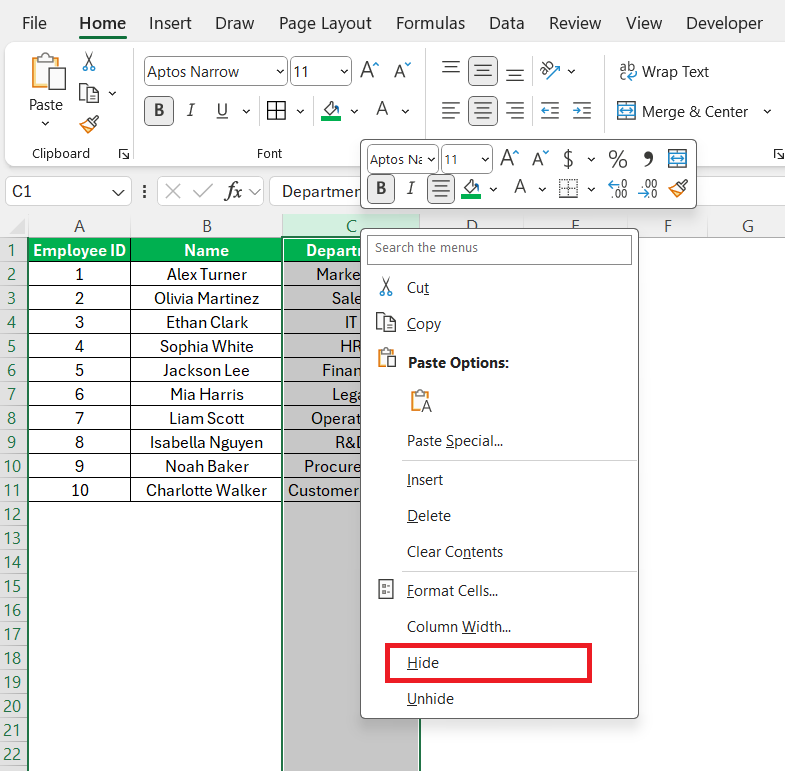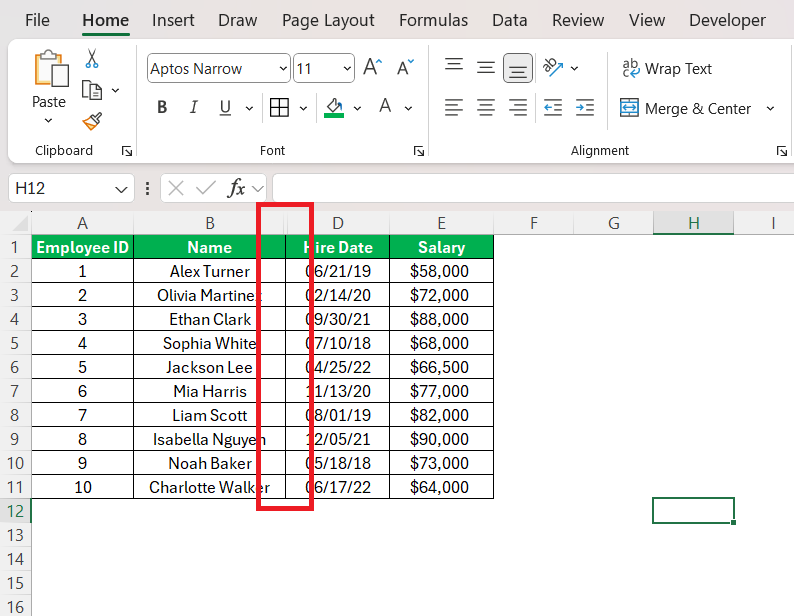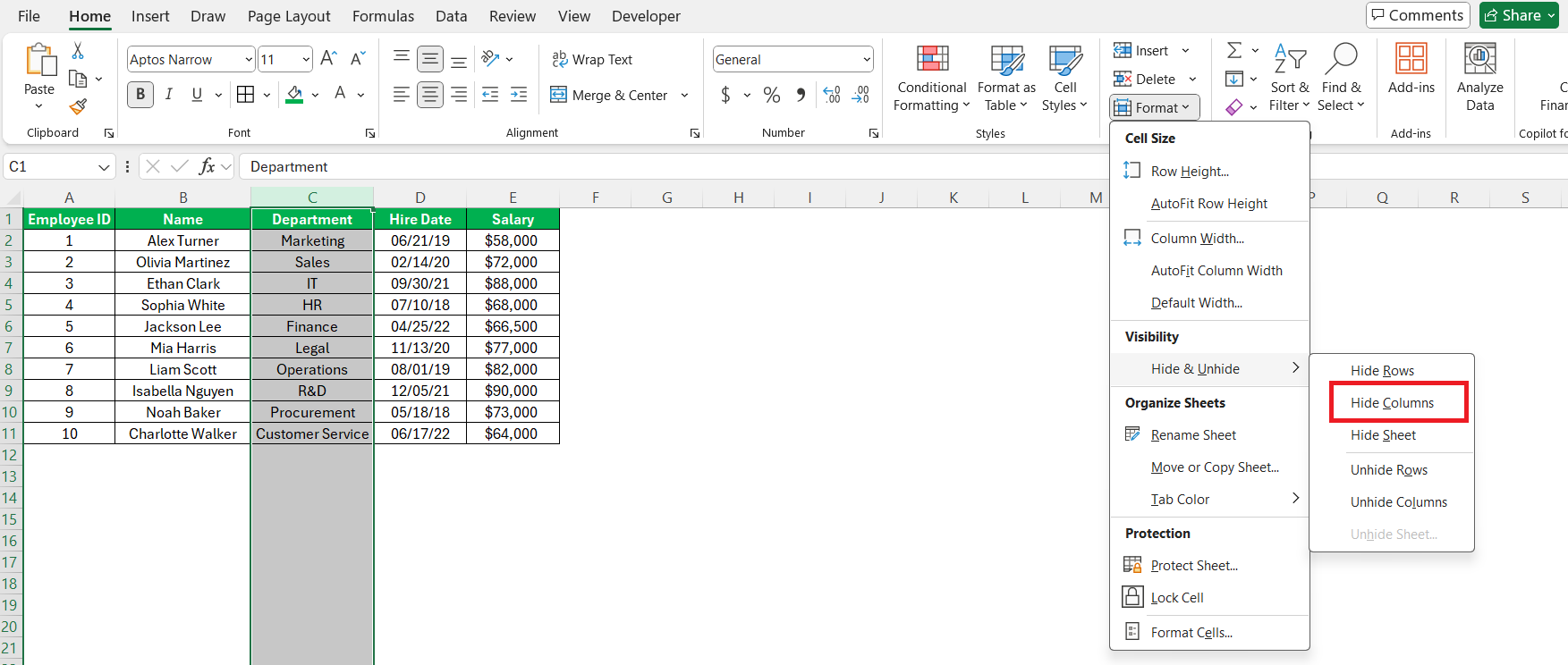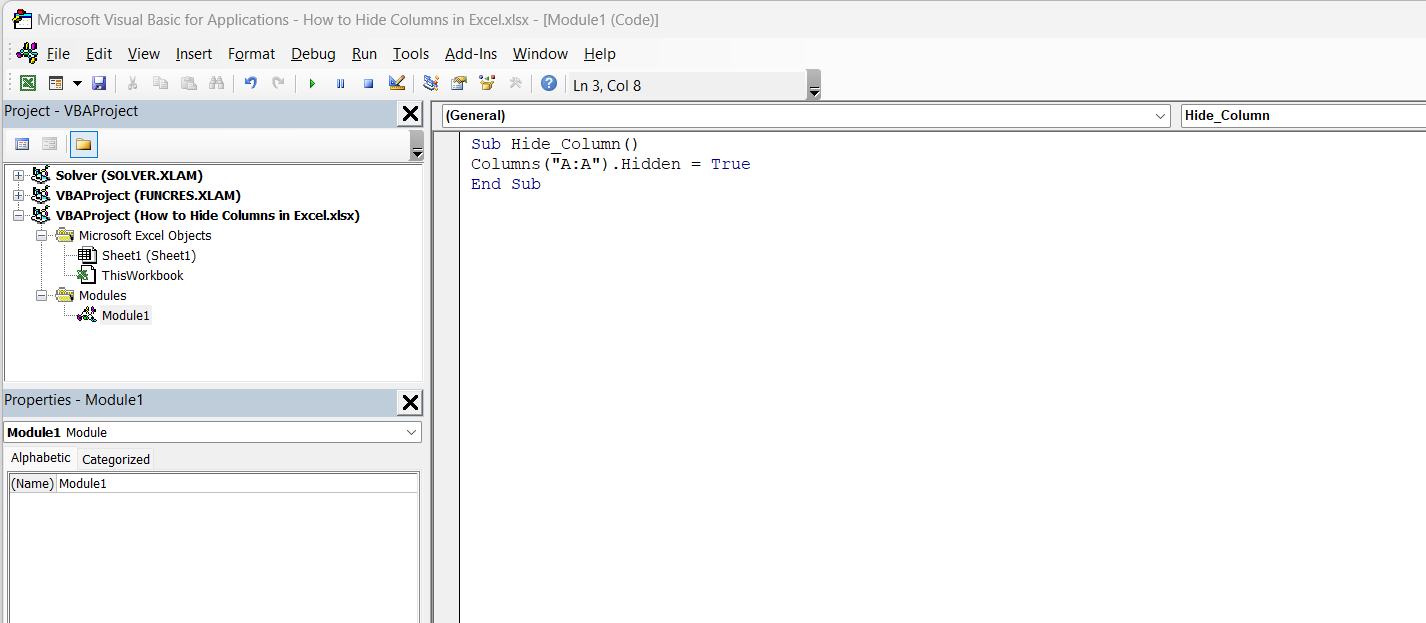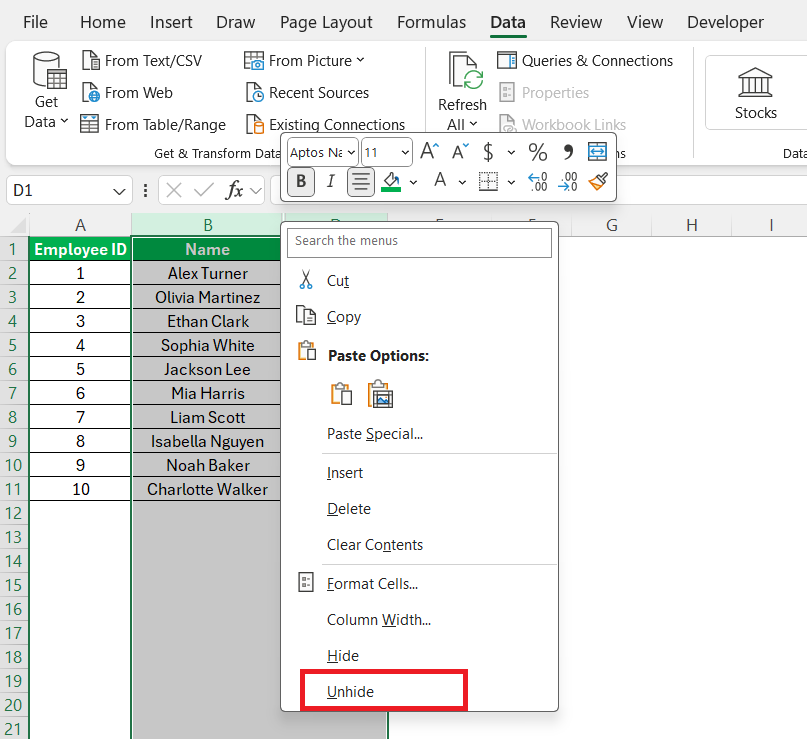When working with large datasets in Excel, there are times when certain columns can become more of a distraction than a help. I often find that hiding these columns keeps my workspace clean and focused. In this article, I’ll walk you through simple steps on how to hide columns in Excel, helping you streamline your spreadsheet and keep your data organized. Whether you’re a beginner or more advanced, these tips will make your workflow smoother.
Key Takeaways:
- Hiding columns in Excel helps maintain a clear and focused workspace.
- You can easily hide columns using a right-click or keyboard shortcuts.
- Advanced users can hide columns via the ‘Format’ option or using VBA scripts.
- Grouping columns is an effective way to manage related data efficiently.
- Protect hidden columns with security features to prevent unauthorized access.
Introduction to Excel’s Hidden Features
The Need for Hiding Columns in Data Management
In the realm of data management, we often encounter the need to streamline our spreadsheets to enhance focus and efficiency. Hiding columns in Excel allows us to maintain laser-like attention on pertinent information by temporarily removing extraneous data from our field of view.
This is especially valuable when dealing with extensive datasets where certain data points, although necessary to keep on record, can become a visual distraction during analysis or presentation tasks.
Maintaining a Clear Workspace with Excel
A clear workspace in Excel can be the difference between an overwhelming spreadsheet and a user-friendly document that highlights what’s important. For us, hiding columns is akin to tidying up a desk; it clears the clutter and enables us to concentrate on the work that matters.
By choosing to hide unused or less important columns, we create a cleaner, more focused workspace which makes navigating our data easier and, invariably, boosts productivity.
How to Hide Columns in Excel
Simple Right-Click to Hide
One of the simplest methods to hide columns in Excel is by using a straightforward right-click. I select the column or columns that I want to conceal and then right-click on the selected column header. From the context menu that appears, I just choose ‘Hide,’ and the job is done.
The columns vanish from view, leaving a seamless interface that implicitly suggests that there’s more to the dataset than meets the eye.
Keyboard Shortcuts: The Faster Route
Certainly, keyboard shortcuts are our speedier route for those of us keen on efficiency. By selecting a cell within the column we wish to hide and pressing “Ctrl + 0”, the column discretely slips out of view. It’s an instantaneous action; no menus, no mouse clicks – just a quick combination of keys and it’s as if the column was never there.
This is particularly useful when there’s a need to hide multiple columns one after another, as the fluidity of quick keystrokes significantly cuts down on time.
Advanced Techniques for Power Users
Using the ‘Format’ Option to Disappear Columns
For those of us with a penchant for menu navigation, Excel’s ‘Format’ option offers another avenue to invisibility for columns. After selecting the column or columns I intend to hide, I navigate to the ‘Home’ tab, dive into the ‘Cells’ group, and select ‘Format’. Following the drop-down menu, I click on ‘Hide & Unhide’, and then ‘Hide Columns’.
With this approach, the columns retreat out of sight, stored neatly away from the current view, ready to be summoned back when needed.
Visual Basic for Applications (VBA): Custom Scripts to Hide
Diving into the realm of Visual Basic for Applications (VBA) propels us into a world where customization and automation take center stage. For those of us who appreciate a tailor-made experience or need to perform regular tasks on complex datasets, VBA scripts are a true game-changer. We commence this journey with the VBA Editor, calling forth our hidden columns with a few lines of code.
By customizing the VBA example provided earlier:
Sub Hide_Column()
Columns("A:A").Hidden = True
End Sub
After running this simple script, the columns are hidden quietly behind the Excel interface, ready to reappear with a similar command to make them visible again.
Special Circumstances and Considerations
Grouping Columns for Organizational Efficiency
Grouping columns in Excel is akin to organizing files into folders; it offers an incredibly efficient way to manage sections of data that belong together. By selecting related columns and then using the Data tab to choose ‘Group’, I can create a collapsible and expandable section.
This function is particularly handy when dealing with large tables that span numerous columns, as it allows me to collapse and summarily minimize sections to focus on the most pertinent areas, without having to scroll endlessly. It improves not just visual organization but also interaction with our data.
Protecting Sensitive Data by Hiding Columns
Protecting sensitive information is a responsibility we take seriously. In Excel, hiding columns is a fundamental step to safeguard employee details, financial records, or any confidential data contained within our spreadsheets. By selectively hiding these columns, we can prevent unauthorized viewing during presentations or while sharing the spreadsheet with others who may not require access to sensitive columns.
However, we should remember that this measure is not foolproof and should be coupled with password protection or other security features for a stronger defense.
Troubleshooting Common Issues
What to Do When You Can’t Find Hidden Columns
If you ever find yourself struggling to locate hidden columns, don’t fret; there’s a straightforward solution. Firstly, try selecting the columns adjacent to where the hidden columns should be. Then, right-click and select ‘Unhide’.
Should this fail, it could be that the workbook is protected, or perhaps the columns are very far apart – in these cases, select the whole document and unhide. Remember, Excel will not conceal columns without a trace; they’re always there, just a couple of clicks away from being revealed.
Avoiding Common Mistakes When Hiding Columns
As we master the art of concealing columns in Excel, it’s crucial to be mindful of common pitfalls that could disrupt our workflow. A frequent misstep occurs when we inadvertently hide columns with critical formulas or links.
Before hiding, I ensure the columns do not contain such essential information. Likewise, if working collaboratively, I inform my team about the hidden data to avert any confusion. Caution is paramount; it’s always better to verify twice than to hide once and cause a cascade of mistakes in our dataset.
Tips and Tricks for Maximum Productivity
Utilizing Excel Shortcuts Beyond Hiding Columns
Maximizing productivity in Excel often involves harnessing the full power of keyboard shortcuts, extending well beyond simply hiding columns. For instance, navigating swiftly between cells, worksheets, and workbooks with shortcuts like “Ctrl + Arrow keys”, “Ctrl + Page Up/Page Down”, and “Ctrl + Tab” can significantly expedite our tasks.
As we familiarize ourselves with these shortcuts, they become second nature, transforming the way we interact with our spreadsheets—leading to faster, more accurate data management.
Streamline Your Workflow with Customized Context Menus
Equipping our Excel toolkit with customized context menus is an ingenious way to streamline our workflow. By tailoring right-click menus to include frequently utilized functions specific to our tasks, we spare ourselves repetitive navigation through menus and toolbars.
Customizing context menus requires a foray into Excel’s options or possibly employing VBA for more advanced customizations, but the payoff in efficiency is substantial. Tailoring Excel to our unique usage patterns is an investment that yields compounded productivity returns over time.
Frequently Asked Questions (FAQ)
Can You Hide Multiple Columns at Once Efficiently?
Yes, hiding multiple columns efficiently in Excel is achievable. You can select a range of adjacent columns using the mouse or Shift key and then either right-click to choose ‘Hide’ or use the keyboard shortcut “Ctrl + 0”. For non-contiguous columns, hold the Ctrl key while clicking on each column header you wish to hide, then right-click on one of the selected headers and choose ‘Hide’. These methods ensure swift action and a tidy worksheet.
Is There a Way to Unhide All Columns Simultaneously?
Absolutely, to unhide all columns at once in Excel, select the entire sheet by clicking on the corner button above row numbers and to the left of column letters. Then, right-click any column header and select ‘Unhide’. Alternatively, using the shortcut “Ctrl + Shift + 0” will reveal all hidden columns instantly, ensuring a quick return to a fully visible dataset.
How Can I Prevent Others from Unhiding Protected Columns?
To keep hidden columns secure and prevent others from unhiding them, you should protect your worksheet. Head to the ‘Review’ tab, click on ‘Protect Sheet’, and set a password. Ensure the option to format columns isn’t available to other users. By doing so, even if they suspect the existence of hidden columns, without the password, they won’t be able to unhide and access the protected data.
How do I hide specific columns in Excel?
To hide specific columns in Excel, you select the column by clicking on its lettered header, then right-click and choose ‘Hide’ from the context menu. Alternatively, using the ‘Format’ option in the ‘Cells’ group under the ‘Home’ tab, select ‘Hide & Unhide’, then ‘Hide Columns’. If you prefer shortcuts, “Ctrl + 0” will also do the trick quickly.
What is the shortcut for hide columns in Excel?
The shortcut to hide columns in Excel is “Ctrl + 0”. To use it, first select the column or columns you wish to hide and then simply press “Ctrl + 0”. This command will instantly hide the selected columns from view, streamlining your worksheet management process.
John Michaloudis is a former accountant and finance analyst at General Electric, a Microsoft MVP since 2020, an Amazon #1 bestselling author of 4 Microsoft Excel books and teacher of Microsoft Excel & Office over at his flagship MyExcelOnline Academy Online Course.

